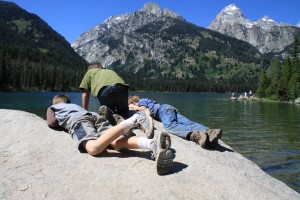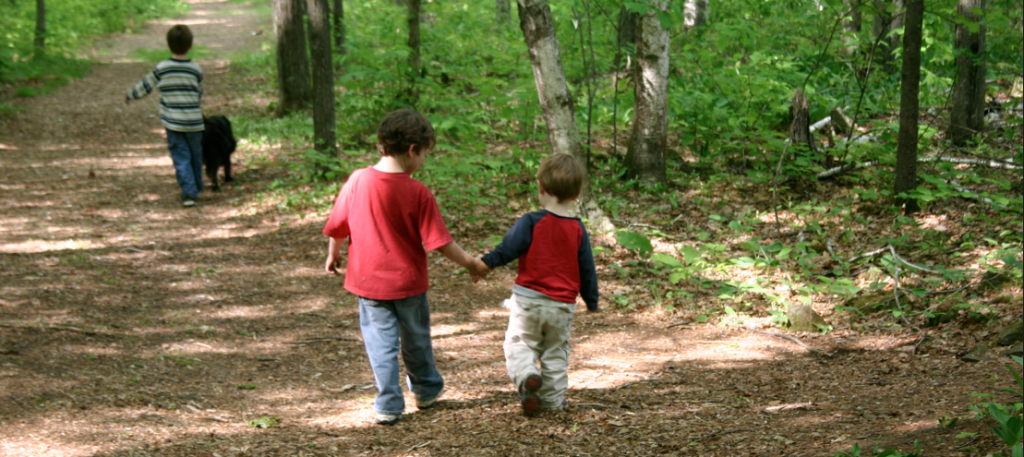One of my favorite “Fit for Life” columns from Mpls/St. Paul, originally published in 2009
Jodi Hiland is not the sort to offer unsolicited advice to parents. She believes we all get quite enough of it already, thank you very much. But on rare occasions, when she finds herself in the company of a squalling infant or a pair of squabbling siblings or a preteen who’s suddenly gotten too cool to participate in conversation, she might make the following suggestion to the child’s parents: “Have you tried going outside?”
Hiland first discovered the sanity- saving effects of the great outdoors when, having exhausted all the other tricks for consoling her crying infant son, she bundled him up and took him outside. “It was like the power switch turned off,” she recalls. His frantic crying was replaced by a sudden calm and an instant curiosity about his new surroundings. “It was like there was something totally familiar and reassuring to him. Like he was saying, ‘Hey, I remember this.’ ”
What she observes now in the faces of her sons when they’re outdoors is what biologists often call “biophilia,” an innate love of living things that may be hardwired into our genetic heritage—and which a growing body of research suggests may be essential to our health. In fact, just being able to see trees from a hospital bed, instead of a brick wall, can speed healing and cut the need for painkillers. Access to green space, gardens, and public parks has been shown to cut the health gap between rich and poor in half. Mother Nature may even be more effective than some medication when it comes to calming active minds: A recent study from the University of Illinois found that a 20-minute nature walk improved the focus of children with attention disorders.
But this good news about the great outdoors comes at a time when people are getting out in nature less. For the first time in history, most people on the planet live in urban areas, and technology has so altered our landscape that a “tweet” is more likely to come from a cell phone than a songbird. All of this helps explain why Hiland founded the Happy Trails Family Nature Club, a loose-knit, non-dues-paying group of parents who gather at parks and nature preserves around the Twin Cities for what Hiland terms “planned spontaneity.’’ She got the idea after reading Richard Louv’s 2005 bestseller, Last Child in the Woods, in which he connects the shrinking amount of time children spend playing outdoors with growing rates of attention deficit, obesity, and depression. (He even came up with a catchy moniker for the problem: “nature-deficit disorder.”)
I must report that none of the dozen or so kids I encountered at a Happy Trails event one unseasonably cold spring night at the Dodge Nature Center in West St. Paul seemed depressed in the slightest—shouting their hellos to a snowy egret making its way through a marsh, climbing and leaping off a stand of trees, and offering helpful suggestions to several adults struggling to make a campfire out of soggy kindling. (“Have you tried lighter fluid?” offered one.) Hiland says this exuberance is the natural side effect of bringing children outdoors, and that helping harried adults see how this works is her only agenda. “I just want to show other parents what we’ve learned, which is when you go out in nature, you teach kids how to shift from one gear to another—and that’s a really important skill to have.”
Happy Trails is one of a growing number of nature clubs across the country, inspired by Louv’s book and driven by the “No Child Left Inside” movement—also the name of an environmental education bill that passed the U.S. House of Representatives last fall. If you think kids don’t need government funding to get outside, it’s a good guess you grew up with the Little Rascals and not The Backyardigans. A 2007 study from the group Natural England found that in only four generations, the natural habitat of childhood has been so constrained that a grandfather who spent his boyhood walking six miles to a favorite fishing hole now has a great-grandson allowed to roam no farther than 300 yards from his front door.
Part of this confinement in play space can be blamed on the spread of cities—after all, the unpaved county roads where I spent long hours on my 10-speed pedaling nowhere in particular have all been filled in with suburban subdivisions with no sidewalks. And while my kids could theoretically walk to our neighborhood school, the street they’d have to cross looks like a freeway most mornings—which is why most parents in my neighborhood fire up the minivan for the eight-block ride.
But Marti Erickson, a retired University of Minnesota developmental psychologist—who, with Louv, was one of the founding members of the nonprofit Children & Nature Network—suggests my generation’s trust issues go beyond that busy crosswalk. “This is a generation of parents who are really caught up in fear,” says Erickson, who hosts the local FM 107.1 radio show Good Enough Moms with her daughter Erin Erickson Garner. The 24/7 news cycle, with its appetite for lost and endangered children, has reinforced the idea that letting kids explore the world around them is unsafe. Add to that the lure of cable TV, iPods, Facebook, and the siren call of organized soccer, and the average child now spends three hours a day in front of a television and gets only 30 minutes of unstructured play outdoors—every week.
The loss of that downtime comes with a downside. A recent study from the journal Pediatrics found that kids who had 15 minutes or more of recess every day were better behaved and performed better in school than kids who didn’t get that downtime. Another study from the Journal of School Health found that the more physical fitness tests students passed, the better they did on academic tests.
“Isn’t this what teachers have known for generations?” asks Megan O’Hara, chair of Minnesota Children and Nature Connection, a resource group aimed at connecting kids to the outdoors. “You release kids into the outdoors and let them run wild, and when they come back they’re calmer and more focused.” O’Hara, who is married to Minneapolis mayor R. T. Rybak, believes that adults are the target audience for this message and may just need some extra encouragement to leave their comfort zones. “We have all of these beautiful parks in the Twin Cities and fantastic nature programs, but one of the things you hear from [park employees] is they need help reaching out to families,” O’Hara says, noting that the first hurdle is “often parents who don’t want their kids to get dirty or get wet”—two things we’ll have to get over if we want our kids to reap the benefits of going outdoors.
Fortunately, the kids I met at the Happy Trails walk seemed to understand this fact intuitively, taking turns rolling down a grassy berm, pulling rocks from a muddy creek bed, and setting out with flashlights to “go find some wolves” (even though their parents explained that wolves are not native to West St. Paul). The promised bonfire at the end of the trail never fully ignited, but even so, Hiland was confident the outing had helped to kindle a lifelong love of the outdoors in the kids that night—a love that may even make their lives longer.
Originally published in Mpls/St. Paul magazine, 2009
Take It Outside
June 14 is National Get Outdoors Day, but any summer day is the perfect time to take your kids outdoors, especially if you follow these tips:
Start ’Em Young: Don’t wait until they’re old enough for the rock wall at REI. Babies and toddlers are naturally curious about the environment and only need a little guidance to get started. Go for regular nature strolls, collect cool leaves in your stroller basket, look for birds, or let them nap on a blanket in the backyard. “They’re never too young,” says retired developmental psychologist Marti Erickson, who has equipped each of her toddler grandchildren with headlamps, and who once took an 18-month-old on a canoe trip down Minnehaha Creek. “We did get wet,” she says. “But that’s also part of the fun.”
Think Beyond the Playground: Research shows that kids play more creatively, enjoy problem-solving, and collaborate more in unstructured (read: less adult-controlled) environments. Hang back and let them do their own thing.

